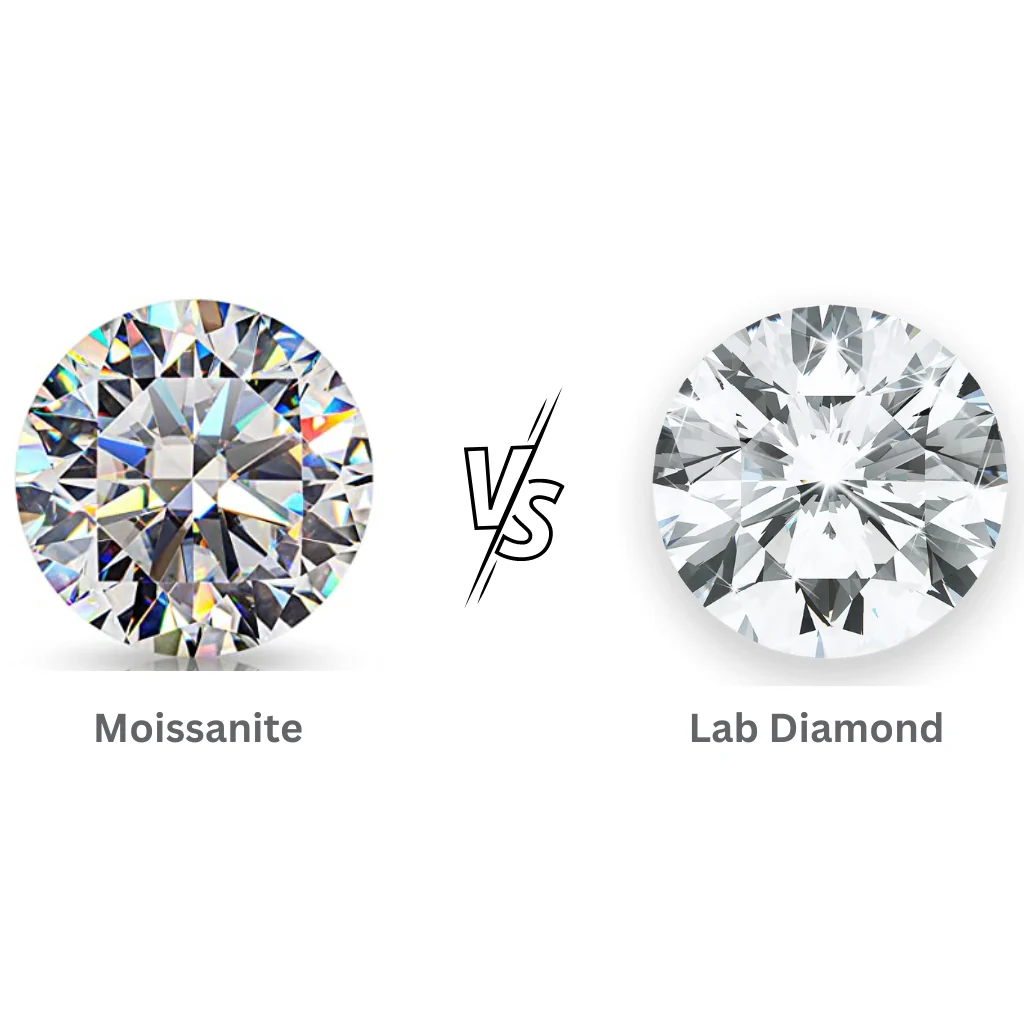When it comes to choosing the perfect engagement ring, the debate between moissanite and diamonds has gained significant traction in recent years. Both gemstones offer stunning brilliance and beauty, but they differ in various aspects that may influence your decision. In this blog post, we’ll dive into the key differences between moissanite and diamonds, helping you determine which is the better choice for your engagement ring.
1. What is Moissanite?
Moissanite is a gemstone discovered by French chemist Henri Moissan in 1893 in a meteorite crater. Initially mistaken for diamonds due to their similar appearance, moissanite is now recognized as a unique gemstone with its own set of qualities. Today, most moissanite is lab-grown, making it an eco-friendly alternative to natural diamonds.
2. Moissanite vs. Diamonds: Key Differences
1. Brilliance and Sparkle
One of the main reasons couples are drawn to diamonds is their famous sparkle. Diamonds have a unique ability to reflect light in a way that creates an impressive display of fire and brilliance. Moissanite, however, takes this up a notch. In fact, moissanite refracts light more efficiently than diamonds, offering even more sparkle. It has a higher refractive index (2.65-2.69) than diamonds (2.42), resulting in a more rainbow-like, fiery sparkle, especially under natural light.
If you’re looking for a stone with maximum sparkle, moissanite may be the better choice.
2. Durability
Durability is a crucial factor when selecting an engagement ring. Diamonds are known for their exceptional hardness, scoring a perfect 10 on the Mohs scale of mineral hardness, making them extremely resistant to scratches and damage. Moissanite, while slightly softer, still ranks high on the scale with a score of 9.25, making it highly durable and suitable for everyday wear.
Both moissanite and diamonds can withstand the rigors of daily life, but if you’re set on the hardest gemstone available, diamonds take the lead.
3. Cost
The cost of a diamond is often one of the biggest factors influencing people’s decisions. Diamonds, especially natural ones, can be incredibly expensive, particularly as carat size increases. Moissanite, on the other hand, offers a much more budget-friendly option without sacrificing beauty or durability. On average, moissanite costs about 10% of what a comparable diamond would, allowing you to purchase a larger stone or a more intricate ring setting for the same price.
For those looking for a high-quality, budget-conscious engagement ring, Moissanite Engagement Rings offer a stunning alternative.
4. Ethical Considerations
Another important factor to consider is the ethical sourcing of gemstones. While many companies now offer conflict-free diamonds, there’s always a lingering concern about the environmental and social impact of diamond mining. Moissanite, being lab-grown, is a more eco-friendly and sustainable option. The process of creating moissanite stones in a laboratory ensures minimal environmental disruption and eliminates the risk of unethical mining practices.
For eco-conscious couples, moissanite is the clear winner in this category.
5. Color and Clarity
Diamonds are often graded based on their color and clarity. Colorless diamonds are the most prized, though diamonds can come in a variety of colors, from yellowish hues to fancy colored stones like pink and blue. Moissanite, by contrast, is primarily found in colorless or near-colorless varieties, though some stones may exhibit faint yellow or grayish tints when exposed to certain lighting conditions.
In terms of clarity, both diamonds and moissanite can be found in a range of grades, but since moissanite is lab-grown, it often exhibits fewer internal flaws than natural diamonds.
6. Resale Value
When considering long-term value, diamonds have historically retained higher resale value than moissanite. Natural diamonds, particularly those with high-quality grading in terms of cut, color, and clarity, often hold their worth over time. Moissanite, while stunning, doesn’t have the same market demand as diamonds, meaning its resale value is lower.
If resale value is important to you, diamonds might be a better investment.
3. Which Gemstone is Right for You?
Choosing between moissanite and diamonds ultimately comes down to personal preference and priorities. If you’re seeking a traditional, timeless gemstone with enduring market value, a diamond might be your best option. However, if you’re more interested in a dazzling, ethically sourced, and budget-friendly alternative, moissanite may be the perfect fit.
Moissanite allows you to achieve the beauty and sparkle of a diamond without the hefty price tag or ethical concerns, making it an increasingly popular choice for engagement rings. Whether you’re drawn to the radiant brilliance of moissanite or the timeless elegance of diamonds, both options offer something truly special for this important symbol of love.
If you’re considering moissanite for your engagement ring, take a look at this stunning selection of Moissanite Engagement Rings to find the perfect ring that matches your style and values.
Final Thoughts
Both moissanite and diamonds have their own unique charm, and either can make a beautiful statement in an engagement ring. Ultimately, the “better” choice comes down to your individual taste, budget, and ethical considerations. Take your time, explore your options, and choose a gemstone that feels right for you and your love story.


